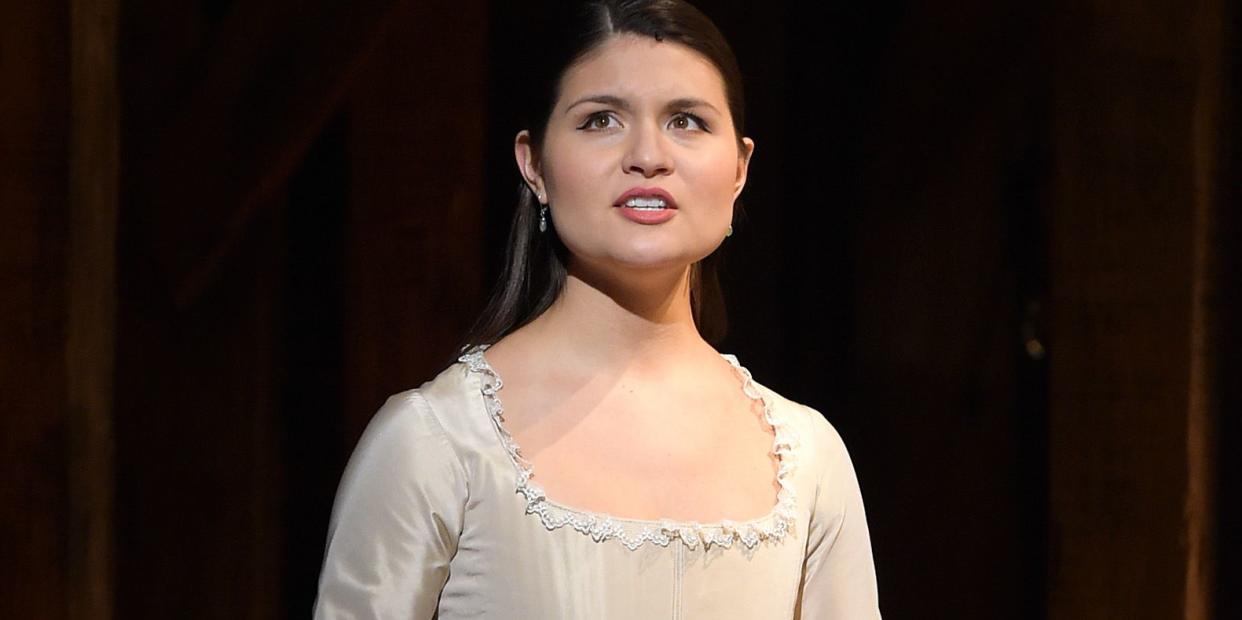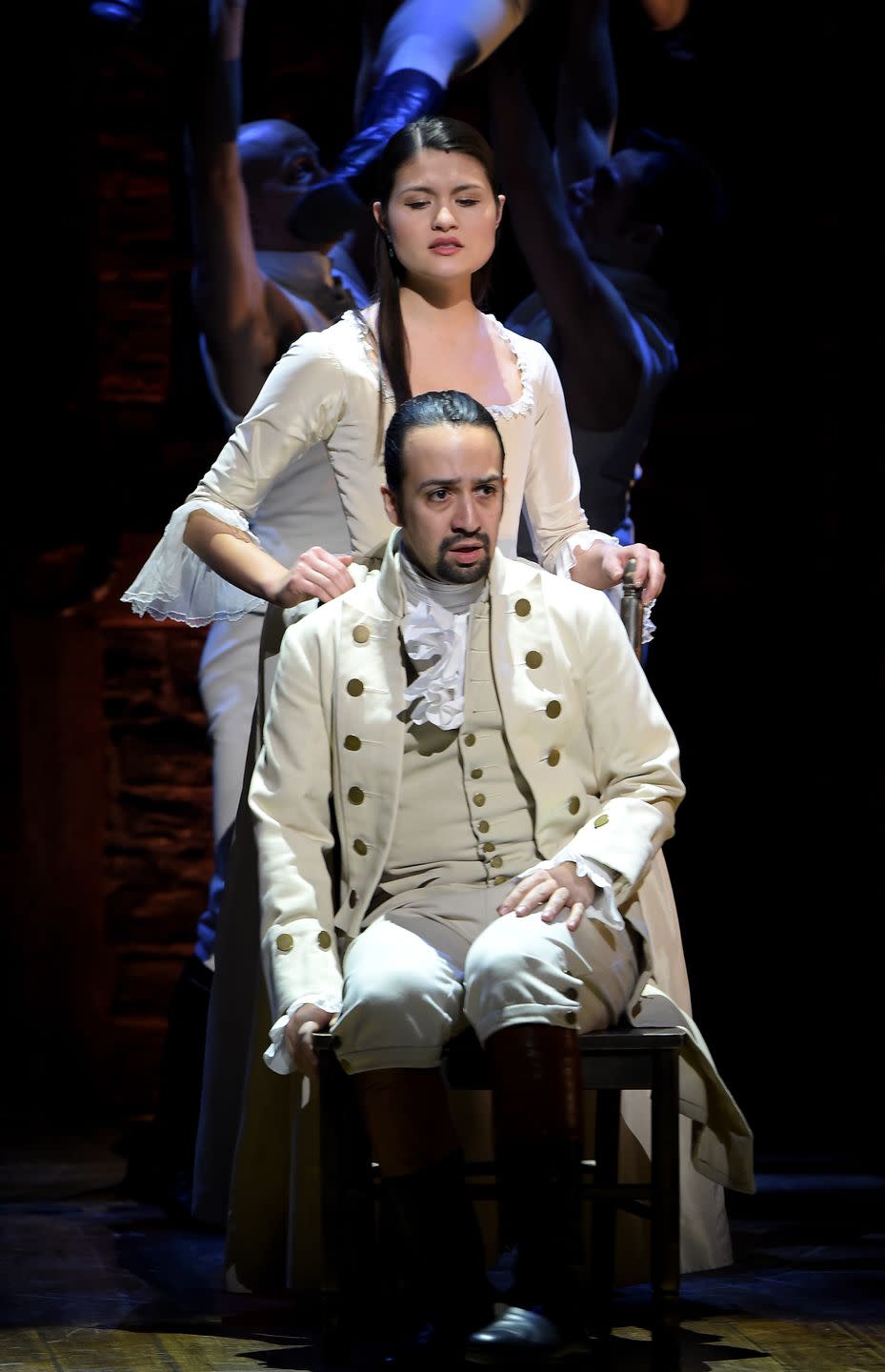The True Story of Elizabeth Schuyler in 'Hamilton'

Summer 2020 has been effectively canceled due to the pandemic, but this weekend, there's reason to celebrate at home. For the first time since its debut in 2015, Lin Manuel Miranda's groundbreaking Broadway hit Hamilton is available to watch from the comfort of your own couch, courtesy of Disney+.
In case you're unfamiliar, the show tells the story of America's revolutionary era through the lens of Alexander Hamilton, and his journey from penniless immigrant to founding father. A number of other familiar historical figures also feature, from Hamilton's friend-turned-nemesis Aaron Burr to his mentor George Washington to his political rival Thomas Jefferson. But by the final act of the play, one of the most compelling characters to emerge is Elizabeth (Eliza) Schuyler Hamilton. Portrayed by Phillipa Soo, Eliza played a key role in safeguarding her husband's legacy after his death. Below, a primer on her real story.
She grew up in a powerful New York family.
Born in 1757, Eliza was the second daughter of Revolutionary War general Philip Schuyler and Catherine van Rensselaer, a member of one of New York’s richest families. Contrary to the musical, the Schuylers had a total of eight children who survived to adulthood, including three sons. The Schuylers owned enslaved people and Philip was reportedly "the largest owner of enslaved people in Albany during his time."
At 22, Eliza met Alexander Hamilton, who was at the time serving under General George Washington, and fell in love "at first sight," per historical accounts. Judging by Hamilton's correspondence at the time, the feeling was mutual. “She is most unmercifully handsome and so perverse that she has none of those pretty affectations which are the prerogatives of beauty," he wrote in a letter to Eliza's sister Angelica, per Smithsonian Magazine. "She has good nature, affability and vivacity unembellished with that charming frivolousness which is justly deemed one of the principal accomplishments of a belle. In short she is so strange a creature, that she possesses all the beauties, virtues and graces of her sex without any of those amiable defects which from their general prevalence are esteemed by connoisseurs necessary shades in the character of a fine woman.”
Historian Jenny L. Presnell writes, "The entire Schuyler family revered Alexander as a young political genius." Alexander and Eliza married on December 14, 1780.

Eliza helped Hamilton write speeches and establish his career.
Eliza was a source of valuable advice and wisdom to Hamilton as his political career began to take off after the war. Along with giving birth to and raising eight children, she helped Hamilton write speeches and listened to early drafts of Washington's "Farewell Address" and excerpts from the Federalist Papers.
Eliza really did destroy her letters.
The song "Burn" is a tearjerking showstopper within the show, as Eliza reacts with despair and rage to the news that Hamilton has been unfaithful to her—and, adding insult to injury, that he's written a pamphlet detailing the affair to the public. Hamilton does this because he's been accused of financial wrongdoing, and wants to make it clear that the suspicious payments he made were to pay off the husband of his lover, Maria Reynolds, rather than "improper speculation." But Eliza, understandably, is devastated, and responds by burning all the letters that Hamilton has ever sent her. "I'm erasing myself from the narrative / let future historians wonder how Eliza reacted / when you broke her heart," she sings, referencing a very real historical ambiguity.
In his 2004 biography of Hamilton, which Miranda used as the basis for the show, Ron Chernow wrote that Eliza destroyed her own letters to Hamilton, but her reasons remain unknown. Her reaction to Hamilton's affair is, equally, lost to history, which Miranda imagines as deliberate in the lyrics to "Burn." ("The world has no right to my heart / the world has no place in our bed / they don't get to know what I said.")

Eliza devoted herself to safeguarding Hamilton's legacy.
After Hamilton's sudden death in a duel with Aaron Burr in 1804, Eliza went on to outlive her husband by close to 50 years. In Hamilton's closing number, "Who Lives, Who Dies, Who Tells Your Story," Eliza is framed as the driving force behind Hamilton's legacy. This is true—she really did saved his writings and fiercely defended his legacy—but she was also as a force for change in her own right. The accomplishment she's proudest of, she says in the song, is founding the first private orphanage in New York City, inspired by Hamilton's own experience of being orphaned at a young age.
In real life, two years after Hamilton's death, Eliza really did help to establish the Orphan Asylum Society of the City of New York, which still exists today as a family services agency named Graham Windham. In 1818, she opened the first school in the neighborhood of Washington Heights (where, decades later, Lin-Manuel Miranda would grow up). The Hamilton Free School was free of cost, because Eliza believed all children should have access to education—specifically in order to read the Bible.
According to Presnell, the years following Alexander's death were marked by poverty for Eliza and her children, though she did raise enough money to re-purchase the couple's home, the Grange. In 1842, she moved to Washington D.C., where she remained a prominent member of society until her death. According to the Smithsonian Magazine, Eliza was a beloved figure and entertained often: "Some visitors sought her imprimatur for new legislation, while others went simply to bask in the glow of history." Eliza died on November 9, 1854, at the age of 97.
You Might Also Like

